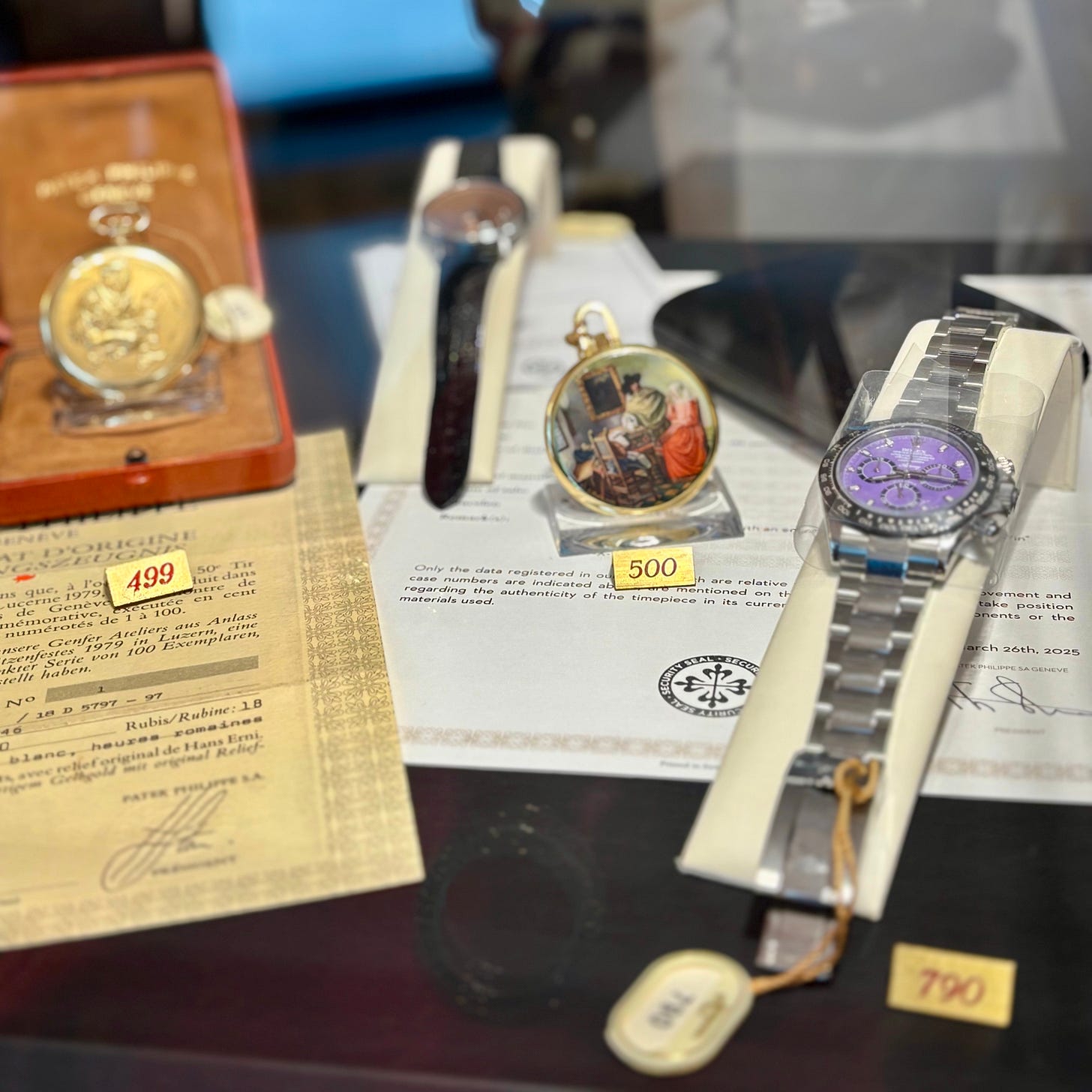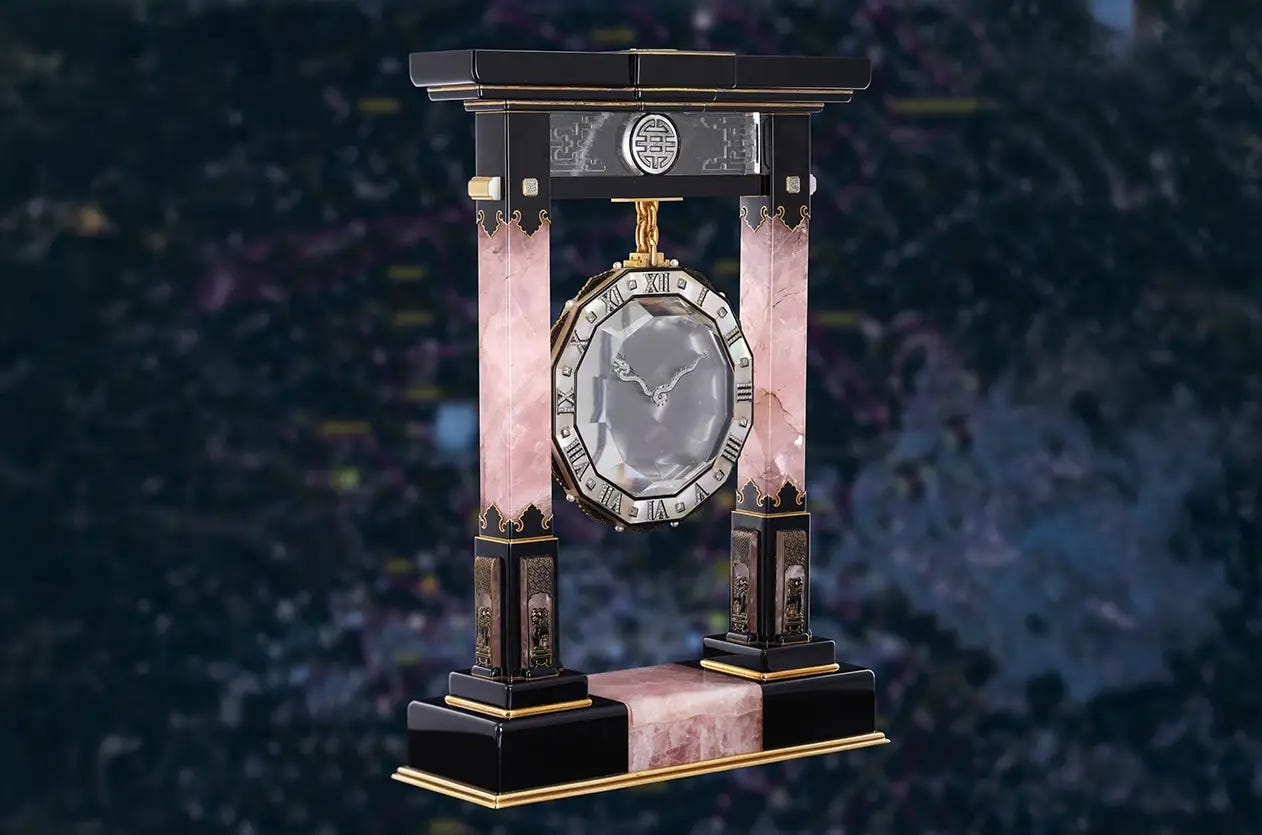Under the Hammer: Watch Auctions in a Changing World
An auction vet reports from inside a changing Geneva landscape
I didn’t go to Geneva for the watch auctions this past weekend, so found myself texting/DMing a few folks during the sales, some mix of FOMO and curiosity about how it felt on the ground.
One of them was Astrid Soyez-Notter, whom I got to know during her five years as a specialist at Antiquorum. Astrid, I said, how’s the energy??
“You want the honest or commercial version?” She asked.
Honest, of course!
“Tough…I think we are heading towards a crisis that will redefine the line of the watch market.”
She mentioned how much of the watch market depends on the “aspirational consumer,” the doctor/lawyer/businessperson who’s done well in life, but isn’t a billionaire with yachts and chateaus, plural.
“Each auction house needs to find its own angle, stick to it, and work on its legitimization,” she added.
Astrid has 15+ years of experience in auctions and luxury (most recently at Antiquorum, which she just left), and I found her perspective insightful, so I asked: “why don’t you write up a full recap from your POV?”
So here it is. —Tony
By Astrid Soyez-Notter
Since the market correction three years ago, watch auction seasons have felt different. Beneath the confident front, there's anxiety. Everyone, from collectors to dealers, is eager to spot the next big trend, knowing early movers can win big. With political, economic, and geopolitical uncertainty, collectors are more cautious, and behind the scenes, tension is high. Auction houses, both established and new, are evolving, reassessing strategies, and redefining their relevance in this shifting market.
Phillips—The Museum Curator
Phillips stands apart as the most curated, compelling, and polished player in the game. From catalog to results—CHF 43.4 million total, more than Christie’s, Antiquorum, and Sotheby’s combined. They’ve mastered the art of turning watches into heritage pieces that give horology historical legitimacy, making buyers feel like they’re buying from a museum.
The clock collection was sublime: the Breguet Pendule Sympathique Clock No. 1, went for $6.5 million, snapped up by F.P. Journe himself. The Cartier Portico Mystery Clock No. 3 (above) followed at $4.5 million. Cartier mystery clocks are Art Deco gems, lavishly opulent pieces that only royalty, aristocracy, and industry titans could afford. This Portico Clock was perhaps the most ornate, one of only six made at the height of the Roaring ‘20s.
Are clocks back?
But my personal favorites?
Lot 135, a Rolex pre-Daytona ref. 6238, with one of the most beautiful glossy black dials I’ve ever seen, the kind of thing I’ll be comparing to future dials I find. It had the price to match, selling for more than half a million Swiss Francs.
Lot 98, a Georges Lenfant-designed Rolex ref. 3236, sold for CHF 68,580—3x its low estimate and proof the shaped-watch craze won’t go away.
Christie’s—The Safe Institution


Held at the elegant Hôtel des Bergues, the room at Christie’s was packed with bidders, browsers, and collectors. Phillips is a party, with music blasting before the sale; Christie’s is more like an old-money dinner party.
The catalog played it equally safe, but solid, even though the catalog cover lot passed, a Patek 2497R with a dial restored by Patek (est. CHF 1-2m). All eyes ended up on the NSO Cartier Crash, which didn’t disappoint. The special order sparked a five-minute bidding war and sold for nearly $900,000. While some trends fade, the Crash endures. It was the auction’s top performer, but also emphasizes the gap for mega watches: Christie’s didn’t have a single watch cross CHF 1 million, while five lots crossed seven figures at Phillips.
Still, with a total of ~CHF 21 million for 181 lots, Christie’s continues to leverage its status as a global auction house to remain a trusted player in watches, too.
Antiquorum—Best Playground for Young Collectors

While the city hosted its annual marathon, Antiquorum ran one of its own, hammering nearly 800 lots in just a day and a half. The most collector-friendly catalog of the week– full of the small, affordable, sometimes forgotten gems that some young collectors are “discovering” (e.g., Bubblebacks, Gallet, Movado, Universal Geneve). The everyday collector-bait often passed over by the bigger auctions.
It rewarded those willing to dig through the clutter with knowledge and patience.
The sale included the “Vogga collection,” 220 lots from the same Japanese collector. No reserve, honest-looking vintage watches—it was a goldmine for treasure-hunting collectors. An exotic Universal Geneve Tri-Compax (CHF 26,250), a well-worn Longines 13ZN “Doppia Lancetta,” (CHF 32,500), and a ton of Gallet chronographs were just a few standouts.
Among the other highlights: the ultra-thin tourbillon prototype by André Beyner and Ebauche SA for Audemars Piguet (covered here), smashed expectations, selling for more than 10x its low estimate (total CHF 187,500)–what this piece of watchmaking history deserved. The final total of CHF 10 million placed Antiquorum third on the podium this season, showing how its strategy paid off.
Sotheby’s—Solid, But Soft Around the Edges
Sotheby’s closed its auction with ~CHF 6.7 million across 125 lots, averaging roughly CHF 53,000 per piece—figures that suggest Sotheby’s is recalibrating in a changing market.
The sale was dominated by neo-vintage, with Cartier leading the charge—almost a quarter of the lots were signed Cartier. A yellow gold 1991 Cartier Paris Crash Paris fetched ~$240,000, a strong result in line with market enthusiasm.
A third of buyers were under 40, proof of Sotheby’s deliberate effort to cultivate a younger, forward-looking client base. But some results highlight the challenge for specialists to balance the expectations of sellers and buyers.
[Notably, Sotheby’s cover lot was also withdrawn, a platinum “Zenith” Daytona, one of four specially commissioned in the 1990s (est. CHF 700k-1.4m). Sotheby’s had sold the previous three, topping out at $3.2m for the lapis version in 2021 when the market was red hot. It also withdrew a Cartier Eight Day Tank, one of only a dozen known (est. CHF 250-500k). In both cases, it’s tricky when there are so few known—best to pull a lot if there are questions. Either way, it can make for a tough sale.—Tony]
The most expensive watch isn’t the most interesting one, and collectors know the difference.
Outsiders—Disruption on the Horizon?
While the major houses took center stage, two outsiders were hosting their previews—ironically right next door to each other. Monaco Legend Group, the rising star that has the big players nervous, held its second Geneva preview in less than three months. It’ll have a sale in June, in Lugano, just two months after its Monaco sale cleared €16.6 million, good enough to make it the third-largest house if you widen the aperture beyond Geneva. Meanwhile, Future Grail, a Singapore-based platform launched by dealer Ali Nael, has a flat 6% commission, and targets global, tech-savvy collectors.
Bottom Line
Finding great watches is only half the battle. The real challenge is putting them in front of the right collectors, at the right time, and doing it with credibility. This season proved it’s not about just having the “best” watches. Today, when transparency matters more than ever, conviction and a clear point of view drive trust—and hammer prices.
Phillips has become known for tightly curated, museum-worthy sales. Christie’s and Sotheby’s, the art giants, are figuring out how to turn loyal, art-savvy clients into serious watch collectors. Antiquorum thrives in the more approachable segment, offering exciting, affordable watches that speak to younger collectors—refining the catalog could help solidify their legitimacy. Meanwhile, on the outsiders front: Monaco Legend Group is edging into Phillips’ territory, while Future Grail brings a digital twist to a more global audience.
The auction houses that know who they are—and who they’re speaking to—are finding the most success.
Astrid Notter-Soyez (Instagram) is an art historian and heritage specialist with 15+ years of experience in auctions and luxury. A graduate of the École du Louvre, she has worked with leading houses including Antiquorum, focusing on horology, historical research, and the curation of watchmaking heritage, with a passion for preserving the cultural significance of watchmaking.
The Roundup
⏳ The clock is ticking on Timex’s Connecticut headquarters (Fast Company). “But now the building is on the verge of being demolished, decades earlier than most buildings of its generation would be threatened. A distribution center has been proposed for development on the site, and Timex, which is now majority owned by a hedge fund, is planning to move out.” The second-highest court in CT has decided to take up an appeal of the lawsuit that had paused the building’s destruction (h/t Dr. Brendan).
The company quietly making rubber straps for most of the watch industry (Worn & Wound)
🏦 A deep, deep dive into Watches of Switzerland Group, and why one guy thinks it’s a great investment—if that’s your thing. “WOSG represents an opportunity to indirectly invest in Rolex, as a significant part of the revenue is generated from Rolex (both firsthand and secondhand watches).”
🪑 The ‘most attractive’ hobbies for men. Maybe you should stop reading this newsletter and pick up woodworking?
🧵 A cool Reddit thread of military service members showing their watches.
“Simplicity is trying to succinctly express the essence of something and its role in our life.”—designer Jony Ive (listen here)
Call for contributors
As today’s auction recap from Astrid shows, Unpolished is also looking for contributors. I’m open to any ideas or pitches. Voicey, insidery, collector-centric, stories that are different. If you’ve got an idea or are interested in contributing to Unpolished, shoot me an email.
Get in touch:
tony@unpolishedwatches.com (use this email, replies to the newsletter often get lost)
❤️ Tap the heart or leave a comment if you enjoyed Astrid’s auction coverage:







Great newsletter - really enjoyed a different perspective on things
I enjoyed the perspective on the roles and positioning of the different auction houses, but I couldn’t reconcile it with the headline of “a crisis that will redefine the line of the watch market”. I can see why it might be coming, as value has become completely misaligned with the means of an averagely well-to-do customer (tho has that ever really been the core customer of high end horology?), but I got no sense of that from the description of each auction house. Ultimately I’m left wondering what is not being said in this newsletter.